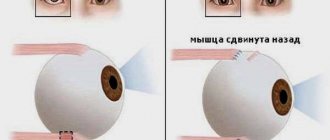At the moment, modern medicine and ophthalmology make it possible to solve almost any problem related to the pathology of the visual organs. Read about how surgery is performed for strabismus and how rehabilitation after surgery proceeds.
In this article
- What is strabismus? We understand the terminology and characterize the disease
- What are the types of strabismus?
- What can cause strabismus?
- Symptoms of strabismus
- How is strabismus diagnosed and what stages does it include?
- Restoring vision in case of strabismus: methods?
- Operations for strabismus
- What results can be expected from surgery to correct strabismus?
- How is surgery to correct strabismus performed? What do you need to know?
- Recommendations for the prevention of strabismus
What is strabismus? We understand the terminology and characterize the disease
Strabismus in professional language is called strabismus and is characterized by impaired binocular vision. This is a disease in which one or both eyes diverge from each other (or converge towards each other) and deviate from the point of fixation. This pathology is most often encountered by children, but sometimes adults also develop strabismus during life. In children under three years of age, strabismus is absolutely normal, since at birth the muscles are weak and not synchronized. If the disease does not go away by a certain age, you should immediately contact a specialist to solve the problem. The sooner you do this, the greater the chances of eliminating strabismus without resorting to surgical intervention. In adults, strabismus appears as an independent disease in the process of complications of other visual pathologies.
Of course, strabismus is not only a cosmetic defect, but also a multifaceted disease, during which the development of the entire visual system suffers, as well as decreased vision and a perception disorder.
Preparing for surgery
The operation to treat strabismus requires preliminary preparation. First, the patient undergoes a full examination by an ophthalmologist, the doctor determines the degree of strabismus and its causes.
Next, the patient undergoes a full set of tests necessary in preparation for any surgical intervention. These are blood tests, including sugar tests, and urine tests. Other tests may be ordered depending on the patient's health.
The patient needs to consult a neurologist and cardiologist. The operation is performed under local anesthesia and is considered low-traumatic, so it can be performed on small children and people with heart disease, but the surgeon must know exactly all the features of the body. A comprehensive examination before surgery will help avoid complications.
A few days before surgery, the patient is prescribed eye drops. They disinfect the eye to avoid infection during surgery.
Before surgery, a gentle diet is necessary: avoiding heavy foods, allergens, and alcohol.
What are the types of strabismus?
Ophthalmologists distinguish the following types of disease: paralytic or concomitant.
- Paralytic, as the name implies, appears in the process of paralysis or injury. It can also be triggered by the presence of a tumor or infection. With this type of pathology, there is an absence or limitation of the mobility of the squinting eye on the side of the paralyzed muscle, inequality of the primary and secondary angles of deviation (the secondary is always greater than the primary), and diplopia is diagnosed. The latter term refers to the bifurcation of objects.
- Concomitant strabismus is primarily associated with impaired visual perception. If a child’s images from the right and left eyes do not form a single visual image, as should be normal, it becomes more convenient for him to look with one eye.
Direction matters too.
- When one eye deviates from the point of fixation, strabismus is called unilateral.
- If both eyes deviate, bilateral strabismus occurs.
- when one or the other eye deviates alternately, they speak of alternating strabismus;
- there is also converging (both eyes look at the bridge of the nose); divergent (eyes directed to temples);
- vertical (deviation up or down) strabismus.
Sometimes horizontal and vertical shapes are combined.
What can cause strabismus?
In a child, strabismus most often appears as a result of a genetic predisposition. Based on the parents' medical history, the ophthalmologist immediately after birth conducts a vision diagnosis and, if necessary, prescribes additional research methods. Among the factors that influence acquired strabismus, it is worth highlighting:
- the presence of myopia and farsightedness;
- advanced stages of astigmatism;
- birth injuries;
- inflammatory processes;
- which may occur in the vessels (for example, strabismus may appear due to conjunctivitis or keratitis).
Other reasons include:
- infectious diseases;
- paralysis;
- injuries or tumors of the eyes or brain.
In children, the development of pathology can be provoked by excessive load on the visual organs and failure to maintain visual hygiene. It is worth noting that the causes of strabismus can be regular stress and some forms of neurosis, which is why correction of strabismus occurs in communication with a neurologist.
Strabismus in children: causes
Strabismus can be either congenital or acquired. The first type is provoked by a variety of factors:
- heredity;
- alcoholism, drug addiction, smoking and poor nutrition of women during pregnancy;
- the birth of a child prematurely;
- congenital pathologies of the visual organs;
- Cerebral palsy.
The causes of acquired strabismus in childhood are:
- refractive errors such as farsightedness and nearsightedness;
- stress;
- heavy eye strain at school;
- infectious eye diseases;
- eye injuries.
Pathology such as strabismus can also be caused by other reasons. Strabismus can occur in newborns; this phenomenon is considered normal.
If symptoms of the disease are observed in a baby after a year, then it is necessary to urgently begin treatment.
Let's find out how you can cure strabismus in a child.
Symptoms of strabismus
The first and main symptom that signals the disease is a displacement of the eyeball to one side or another (depending on the type). In addition, there are a number of symptoms that act as both precursors of pathology and signs accompanying the disease.
It is known that the congenial type is characterized by the inability to fixate on a specific object near or far, depending on whether a convergent or divergent type of strabismus is established. When a person tries to focus, the eyes move apart, but the mobility of vision does not suffer, only its synchrony. It is important to understand that in children, failure to eliminate this problem can lead to the formation of another - “lazy eye” syndrome. While concomitant strabismus is most often a congenital pathology, paralytic strabismus can be diagnosed in children and adults and often takes an acquired form. Key symptom: limited mobility of the affected eye, up to complete immobility. In the process, splitting of objects, rapid fatigue, dizziness and pain are connected to it.
Surgery to correct strabismus
In most cases today, competent ophthalmological surgeons prefer to use the adjustable suture technique
. This is due to its maximum effectiveness, safety, predictability of results and easy tolerability for patients. However, at the Spectrum clinic, the choice of a specific surgical treatment option is always carried out strictly individually, taking into account the characteristics of each patient’s condition.
The essence of this operation remains the same regardless of the person’s age. Six muscles are involved in the oculomotor function. Surgical removal of strabismus
occurs due to the weakening or tightening of the corresponding muscles by the ophthalmic surgeon during the operation.
The technique of adjustable seams involves performing manipulations in two stages:
- An ophthalmic surgeon, under anesthesia, performs the necessary tightening or weakening of the eye muscles, followed by fixation with special threads, tied not in a knot, but in a bow.
- Then, usually the next day, under local anesthesia, the ophthalmologist adjusts the tension of the threads
and places the operated eye in the ideal correct position.
Optimal muscle balance achieved during surgery ensures complete correction of strabismus.
At the Spectrum Clinic, a complete ophthalmological examination of children and adults with suspected strabismus is carried out using the most accurate and modern methods. This allows you to get an accurate picture of the changes, develop the most effective treatment plan or choose a surgical technique to obtain the best results.
The extensive knowledge base and extensive experience of the doctors at the Spectrum clinic, combined with the use of modern equipment and materials, allow us to achieve maximum restoration of eye health for each patient.
How is strabismus diagnosed and what stages does it include?
As is the case with any other diseases of the visual organs, the diagnosis of strabismus is carried out by a specialist and is a full-fledged ophthalmological examination. What stages does it include?
First of all, the doctor examines the patient, then, using hardware techniques, determines visual acuity and mobility of the eyeball, and studies the refractive features of the eye.
Afterwards, an electrophysiological study is involved in the process. It is this that allows us to get an answer to the question, does the patient have organic or functional damage to the visual system?
Remember that treatment methods are chosen personally by the ophthalmologist. Since with strabismus, visual acuity decreases, connections between the eyes in the brain are disrupted, and an imbalance develops between the muscles that move the eyes, treatment is a complex therapy. That is, in most cases, conservative methods alone will not work: you need surgery and hardware treatment that will restore connections and increase severity.
Restoring vision in case of strabismus: methods?
As mentioned above, the ophthalmologist decides what type of vision restoration you or your child needs, based on the medical history and individual characteristics of the body. When treating strabismus, it is necessary to restore binocular vision. Once this is done, the asymmetry of the eye position will disappear, and visual functions will be restored. In this case, ophthalmologists resort to optical, pleoptic-orthoptic treatment, surgical intervention, which is necessarily followed by orthoptodiploptic therapy. It is also performed before surgery. Glasses help restore visual acuity and normalize accommodation with convergence. One of the advantages of this treatment method is that such correction is indicated for any type of strabismus.
Pleoptic treatment is prescribed for amblyopia to increase visual load on the squinting eye. For this purpose, occlusion (exclusion from the vision process) of the fixating eye can be prescribed, penalization, and hardware stimulation of the diseased eye can be used.
The orthoptic method of treating strabismus, which includes computer programs and synoptic devices, allows you to regenerate the binocular activity of both eyes.
Most often, at the final stage of strabismus treatment, ophthalmologists strongly recommend diploptic therapy. Thanks to training with lenses and prisms, she makes binocular vision “work” in natural conditions. Gymnastics are also prescribed to improve eye mobility and training on a convergence trainer.
How to cure strabismus in children?
Strabismus in children can be cured using hardware methods and gymnastics. However, for this you need to consult an ophthalmologist in a timely manner. He will select therapy for the patient, and parents will need to strictly follow all the doctor’s instructions. Whatever method of treating strabismus is used, any therapeutic course will consist of several stages:
- First, amblyopia—lazy eye syndrome—is treated. At this stage, it is necessary to bring visual acuity to normal. To do this, the patient is prescribed to wear glasses, one lens of which is sealed. For children, special stickers with interesting images are used. In parallel, hardware treatment is carried out.
- At the second stage, the synchronicity of the movement of the eyeballs is restored. Instruments, devices and computer programs help with this.
- The essence of the third stage is to restore the muscular balance between the eyes. If the muscle damage is very severe, surgery may be required at this stage of treatment. Often, in childhood, you can tone the eye muscles at home. For this, the doctor will select a set of suitable exercises.
- At the fourth stage, binocular vision is restored. By the last stage of treatment, the eyes should already be in the correct position. Stereoscopic vision is restored through hardware procedures.
Operations for strabismus
Surgery is the last stage in the treatment of strabismus. That is, it is resorted to at the end of conservative treatment, since an integrated approach in this case is extremely important. Of course, sometimes surgery can be avoided, but statistics show small indicators on this issue. Looking ahead, we note that surgery to correct strabismus in children is carried out in the same way as surgical correction of strabismus in adults.
Experts advise performing strabismus surgery in children aged three to five years. To eliminate the disease, there are several types of surgical interventions: weakening and strengthening the function of the extraocular muscles.
The first type of surgery to eliminate strabismus is carried out by transplanting a muscle or cutting a tendon, the second, in turn, by shortening the muscle.
How is surgery to correct strabismus performed? This question is considered one of the most pressing among people faced with this problem. Only an ophthalmologist can answer this and other questions, because when choosing the type of operation to eliminate strabismus, many factors are taken into account: the location of the muscles, the angle of strabismus, the condition of the oculomotor system, age and others. Usually several muscles are operated on at once, sometimes both eyes at once. In some cases, types of strabismus surgery are combined on both eyes, on both strong and weak muscles. Such manipulations are carried out in stages.
Regardless of the type of operation that the ophthalmologist and surgeon chooses, based on the characteristics of the body, before and after the operation it is necessary to resort to ortopic and diploptic treatment. This is done in order to eliminate the residual deviation.
Treatment methods for strabismus
Strabismus is most often caused by problems with the eye muscles. When a patient's squinting eye sees, but the brain cannot merge two images into one, ophthalmologists try to treat strabismus in a conservative way. To do this, the healthy eye is excluded from the vision process, for example, covered with a bandage or glasses, and the other eye is stimulated with special devices.
The conservative method is especially effective for treating children. If, after two years of conservative treatment, binocular vision is not restored, the doctor prescribes surgery.
Surgical correction eliminates the cosmetic defect, that is, the eyes look identical in appearance. Binocular vision can be restored by surgery if the visual function of the squinting eye is not lost.
The operation helps to cure alternating strabismus, when the patient looks alternately with the left or right eye. The functions of the eyes are not reduced, but the muscles prevent the eyes from looking in one direction. Correcting the muscles will eliminate this problem.
The best age for surgery is considered to be between 4 and 6 years of age. Congenital strabismus in children can be treated as early as 2-3 years. If strabismus was acquired later, surgery is also possible in adulthood. Western doctors also perform operations on patients up to a year old, believing that early correction is an effective prevention of vision loss in a squinting eye.
If the squinting eye has completely lost visual function and it is impossible to restore it, surgery can be performed at any time, but it will be purely cosmetic.
What results can be expected from surgery to correct strabismus?
A positive aesthetic result and correct image of objects are the main reasons why patients decide to undergo surgery to correct strabismus. Surgical intervention allows you to eliminate the defect once and for all, especially in cases where other methods are powerless. If we talk about the success of this type of operation, it is up to 90 percent.
Of course, complications in the form of overcorrection or, conversely, insufficient correction do occur, but in rare cases. The quality of the operation depends not only on the person himself, but also on the symmetry of the position of the eyes, the stability of binocular vision, and visual acuity.
How is surgery to correct strabismus performed? What do you need to know?
How is this operation carried out? We will try to answer this question as fully as possible. The operation for strabismus takes place in one day, in a few hours. This is facilitated by a modern approach and innovative equipment. It is important to follow all the recommendations of the ophthalmologist after strabismus surgery to ensure that the rehabilitation period is minimal. The final restoration of vision occurs within about a week, after which it is imperative to resort to hardware therapy.
Recommendations for the prevention of strabismus
It is best to take preventative measures from childhood. Especially if one of the parents has been diagnosed with the disease. If you consult a doctor in time and follow all the recommendations, you can avoid health problems. In cases where strabismus is caused by external factors, it is important to take care of the visual organs and regularly visit an ophthalmologist and neurologist at least once a year. Do not neglect the rules of visual hygiene, do not overstrain your visual organs, watch your diet and perform gymnastic exercises for the eyes. At the moment, ophthalmology makes it possible to perform operations to correct strabismus using innovative technologies that minimize injuries to the eyeball and preserve the vascular nerve bundles passing through the extraocular muscles.









